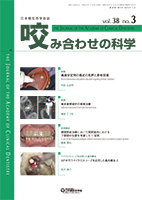Volume 38, Issue 3
Displaying 1-11 of 11 articles from this issue
- |<
- <
- 1
- >
- >|
REVIEW
-
Article type: review-article
2018Volume 38Issue 3 Pages 155-165
Published: November 21, 2018
Released on J-STAGE: June 25, 2020
Download PDF (2219K) -
Article type: review-article
2018Volume 38Issue 3 Pages 166-172
Published: November 21, 2018
Released on J-STAGE: June 25, 2020
Download PDF (2585K)
CLINICAL REPORTS
-
Article type: case-report
2018Volume 38Issue 3 Pages 173-181
Published: November 21, 2018
Released on J-STAGE: June 25, 2020
Download PDF (1841K) -
Article type: case-report
2018Volume 38Issue 3 Pages 182-188
Published: November 21, 2018
Released on J-STAGE: June 25, 2020
Download PDF (1622K) -
Article type: case-report
2018Volume 38Issue 3 Pages 189-197
Published: November 21, 2018
Released on J-STAGE: June 25, 2020
Download PDF (1671K) -
Article type: case-report
2018Volume 38Issue 3 Pages 198-206
Published: November 21, 2018
Released on J-STAGE: June 25, 2020
Download PDF (1256K)
-
2018Volume 38Issue 3 Pages 207-214
Published: November 21, 2018
Released on J-STAGE: June 25, 2020
Download PDF (1072K) -
2018Volume 38Issue 3 Pages 215-224
Published: November 21, 2018
Released on J-STAGE: June 25, 2020
Download PDF (1043K) -
2018Volume 38Issue 3 Pages 225-229
Published: November 21, 2018
Released on J-STAGE: June 25, 2020
Download PDF (889K) -
2018Volume 38Issue 3 Pages 230-237
Published: November 21, 2018
Released on J-STAGE: June 25, 2020
Download PDF (389K) -
2018Volume 38Issue 3 Pages 238-243
Published: November 21, 2018
Released on J-STAGE: June 25, 2020
Download PDF (2106K)
- |<
- <
- 1
- >
- >|
